
VET 2024: which students enrolled where?
In the last fortnight we have seen the release of the full student datasets for higher education and VET.
In two updates I have looked at a key cohort in each sector.
In my first report on the higher education sector I chose to focus on domestic commencing students – as the government prepares to make changes to attract more new students into higher education following the recommendations of the Universities Accord panel.
In this related report on the VET sector, although there are a lot of VET enrolments in single subject courses (eg first aid) and this is legitimate and important VET delivery, I have chosen to focus my analysis on VET program enrolments (ie enrolments in full qualifications and skillsets) as it allows for more useful comparisons across key provider types, training packages and jurisdictions.
VET
The Total VET Activity data managed by the NCVER, while first collected in 2015, is sadly now only publicly available from 2019 onwards – with the exception of these two charts which show an overall decline in VET program enrolments in the last decade (ie full qualifications and skill sets) dropping from 3.1 million to 3 million (-3%), albeit more students are enrolling in VET but these are mainly in single subject programs (eg First Aid, Responsible Service of Alcohol, and other units which frequently are associated with licencing requirements).[1]
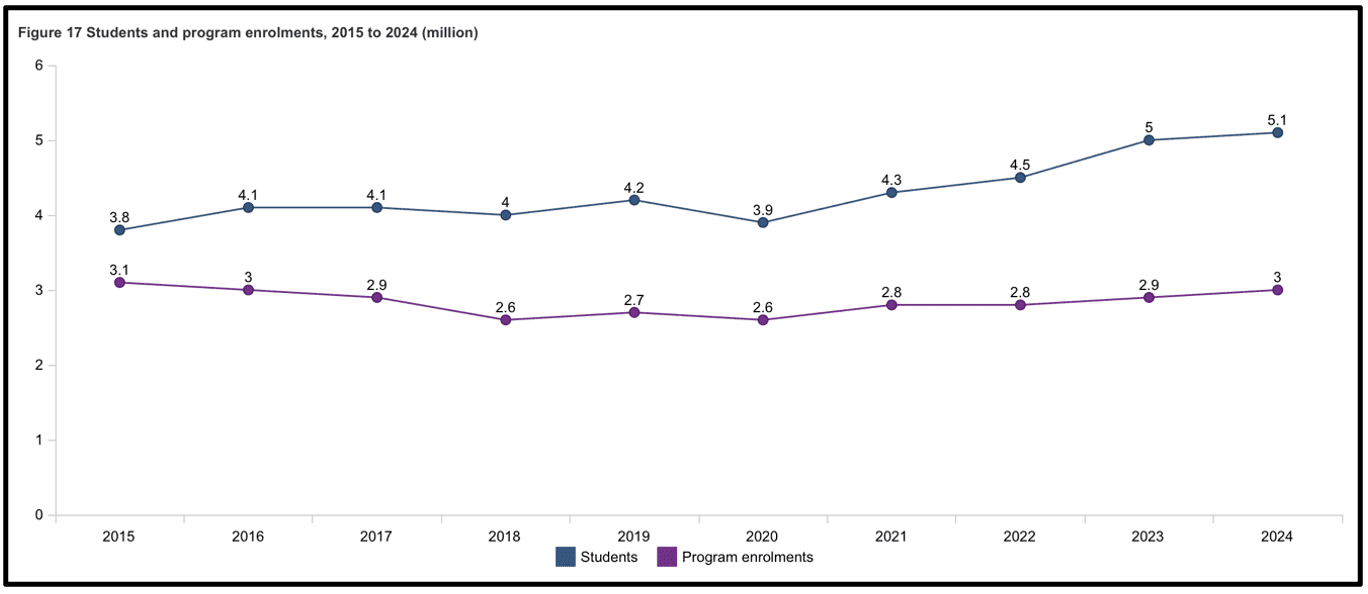
Qualification completions are unchanged over the last decade:
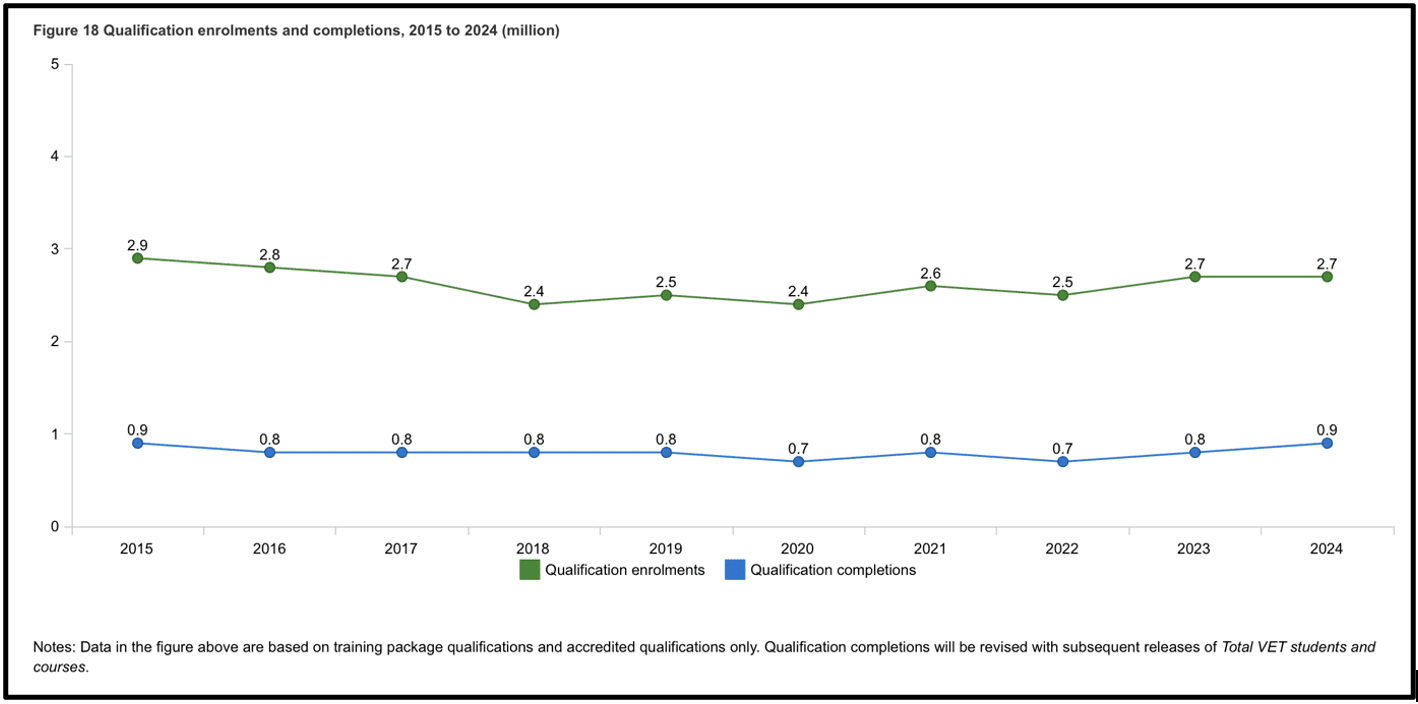
With VET students typically studying for much shorter periods than higher education students – this analysis does not focus on commencing students. Furthermore, as noted above, a lot of VET students enrol in single subjects – and hence this analysis focuses on ‘program enrolments’ that is in qualifications and skillsets.
Top 10 training packages by program enrolments
Firstly it is important to note that there are 11 not 10 ‘training packages’ listed below – and that is because the most popular area of enrolments in TAFE in 2024 is in courses outside national training packages – eg accredited courses (and these courses are also pretty popular at private providers).
It is interesting to see that after 30 years of efforts aimed at standardising VET delivery into national training packages, 20% of all delivery by the TAFE sector is outside of training packages, along with a good proportion of private provider activity.
Turning to the most popular training packages for program enrolments in TAFE/dual-sector universities and the data shows minimal changes in enrolments between 2019 and 2024 in the top 3 training packages: community services (+1%) and business (+4%) have had modest increases, and construction a modest decrease (-3%).
The largest shift in enrolments in TAFE have been in electrotechnology (+23%) and tourism, travel and hospitality (-26%).
Overall program enrolments in TAFE institutes and dual sector universities declined by -1% between 2019 and 2024, and although enrolments grew modestly post-pandemic they peaked in 2023 and again fell -1% to 2024.
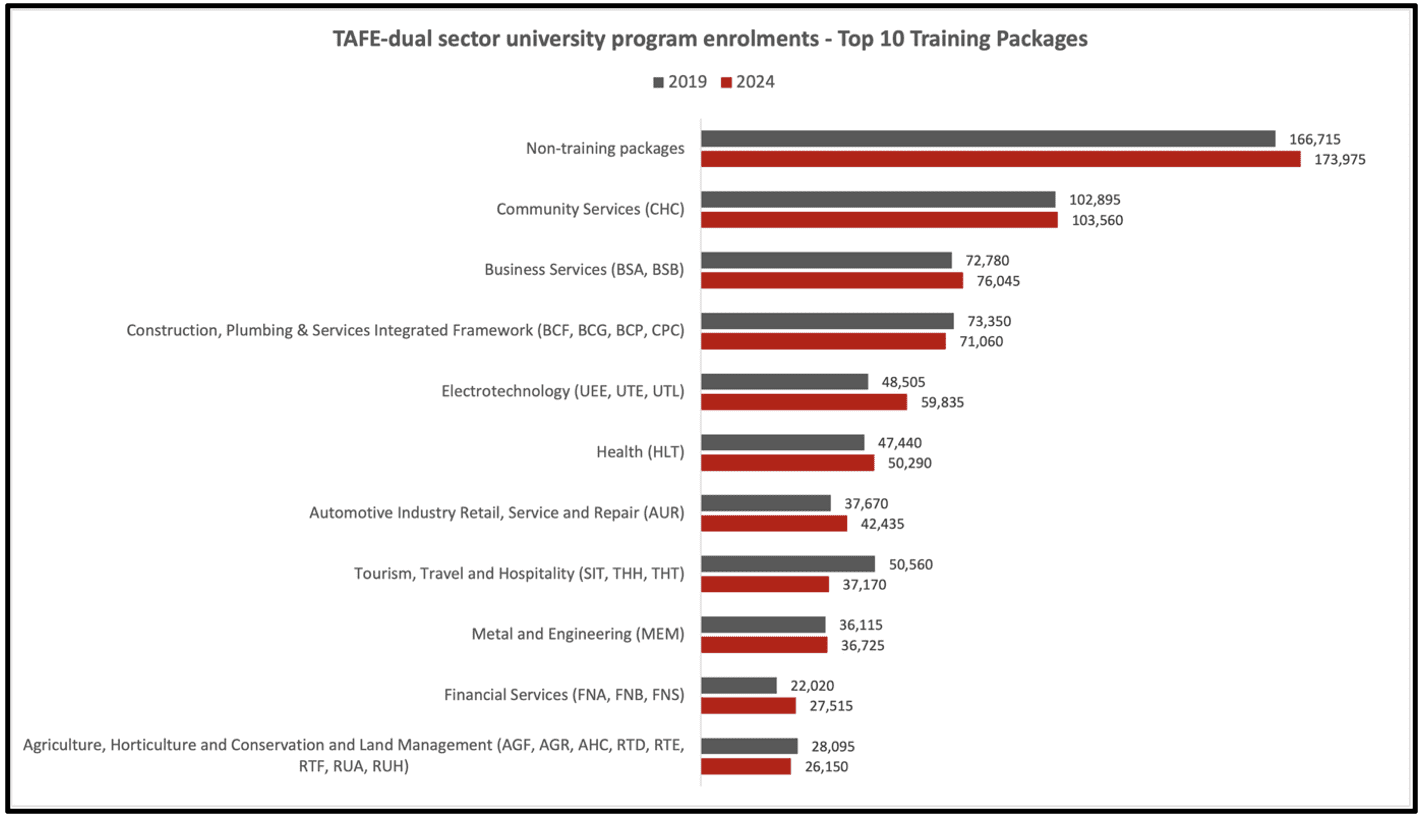
By contrast for private providers there has been significant growth in enrolments in almost all of their Top 10 training packages by program enrolments, with the exception of business services (-13%) and transport and logistics (-48%). Enrolments in all other packages experienced double digit growth between 2019 and 2024.
Overall program enrolments in private providers increased 18% between 2019 to 2024, although the rate of increase between 2023 and 2024 was just 2%.
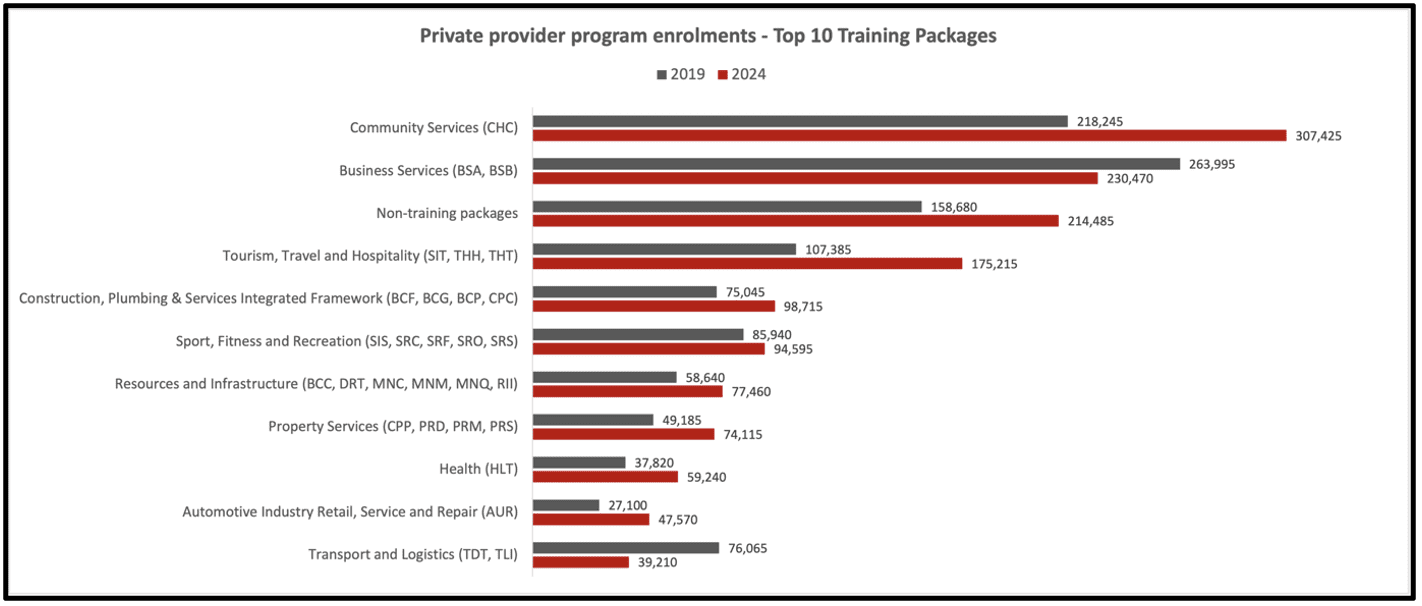
Government-funded enrolments in Top 10 training packages
Government-funded program enrolments in VET have increased by 8% since 2019, domestic fee-for-service enrolments decreased by -1% and program enrolments by international students grew by 40%.
Government-funding for VET shows Australian, state and territory governments’ priorities.
The Top 10 training packages for government-funded program enrolments are shown below. With a high proportion of TAFE enrolments being government-funded it is unsurprising that there are some similarities with the TAFE enrolment patterns.
Noticeably though most government-funded enrolments in community services programs happen outside the TAFE sector. It is also noticeable that tourism, travel and hospitality programs are a higher priority for governments than health – and again most government-funded program enrolments in tourism, travel and hospitality happen outside the TAFE sector.
Government-funded program enrolments in agriculture, horticulture, conservation and land management have declined by -2% since 2019 and by -16% for tourism, travel and hospitality. There has been growth in all other major training packages.
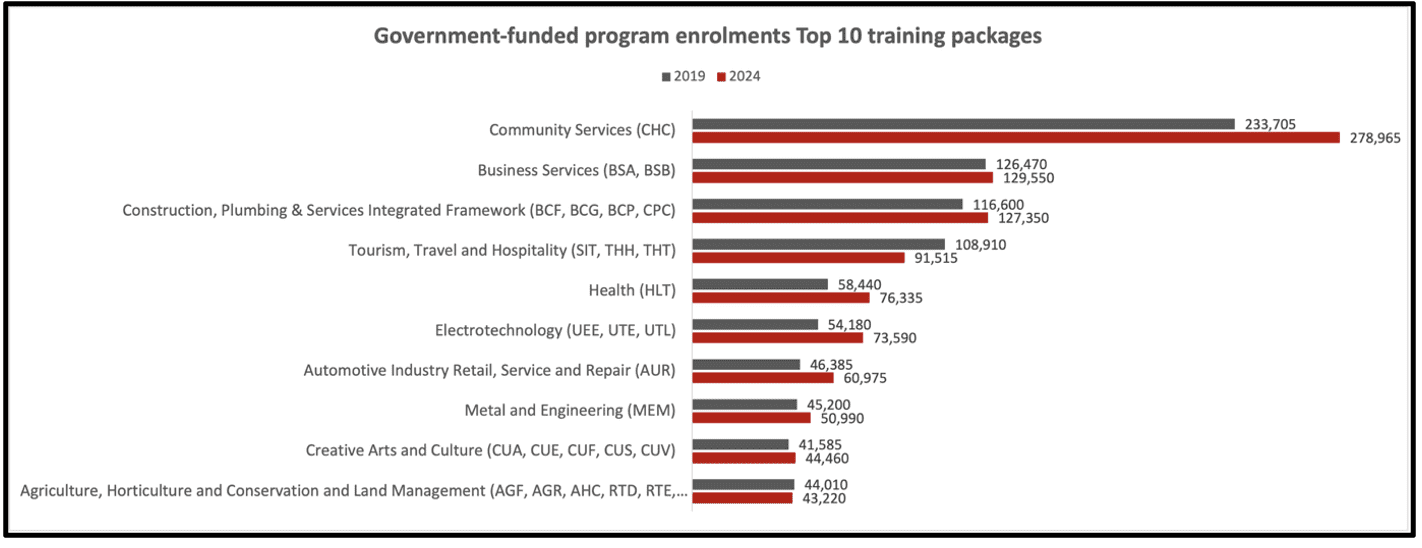
Program enrolments by jurisdiction
Looked at by jurisdiction – aside from the ACT which saw a 20% decline in VET program enrolments between 2019 and 2024, there was growth in enrolments in all other jurisdictions.

The pattern of overall growth was not uniform though and declines in program enrolments between 2019 and 2024 occurred for the following groups in the following jurisdictions:
- NSW – domestic fee-for-service: -12% (could this be partly linked to the growth in private higher education commencing students outlined above given there is such a high proportion of domestic non-university higher education students studying with NSW providers?)
- SA – government-funded: -1%
- SA – domestic fee-for-service: -18%
- NT – domestic fee-for-service: -7%
- ACT – government-funded: -30%
- ACT – domestic fee-for-service: -22%
AQF-level differences in program enrolment changes
The data shows growth in government-funded program enrolments predominantly in Certificate III and Certificate IV level courses and in ‘non-AQF level’ courses. Government funded enrolments in entry-level programs at Certificate I and II declined between 2019 and 2024.
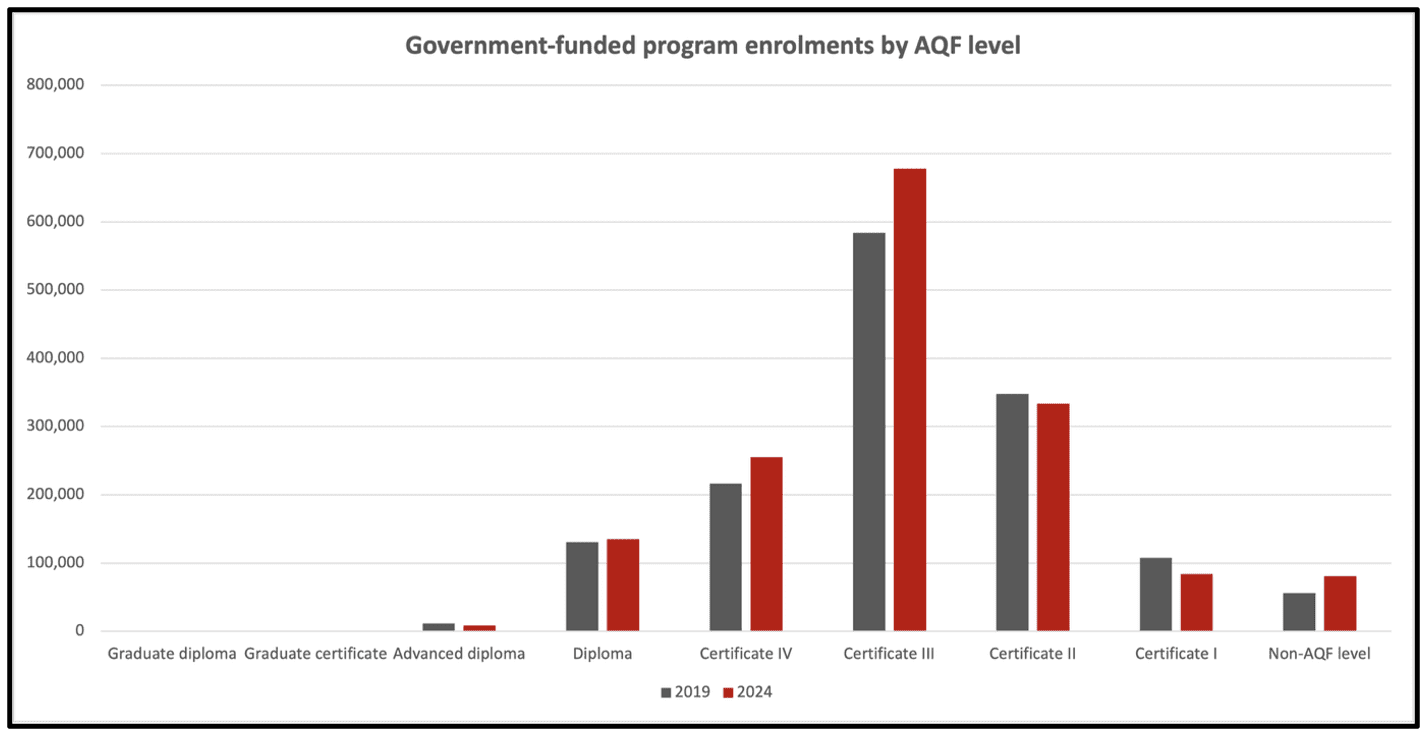
And domestic fee-for-service enrolments show similar patterns of enrolments growth between 2019 and 2024.
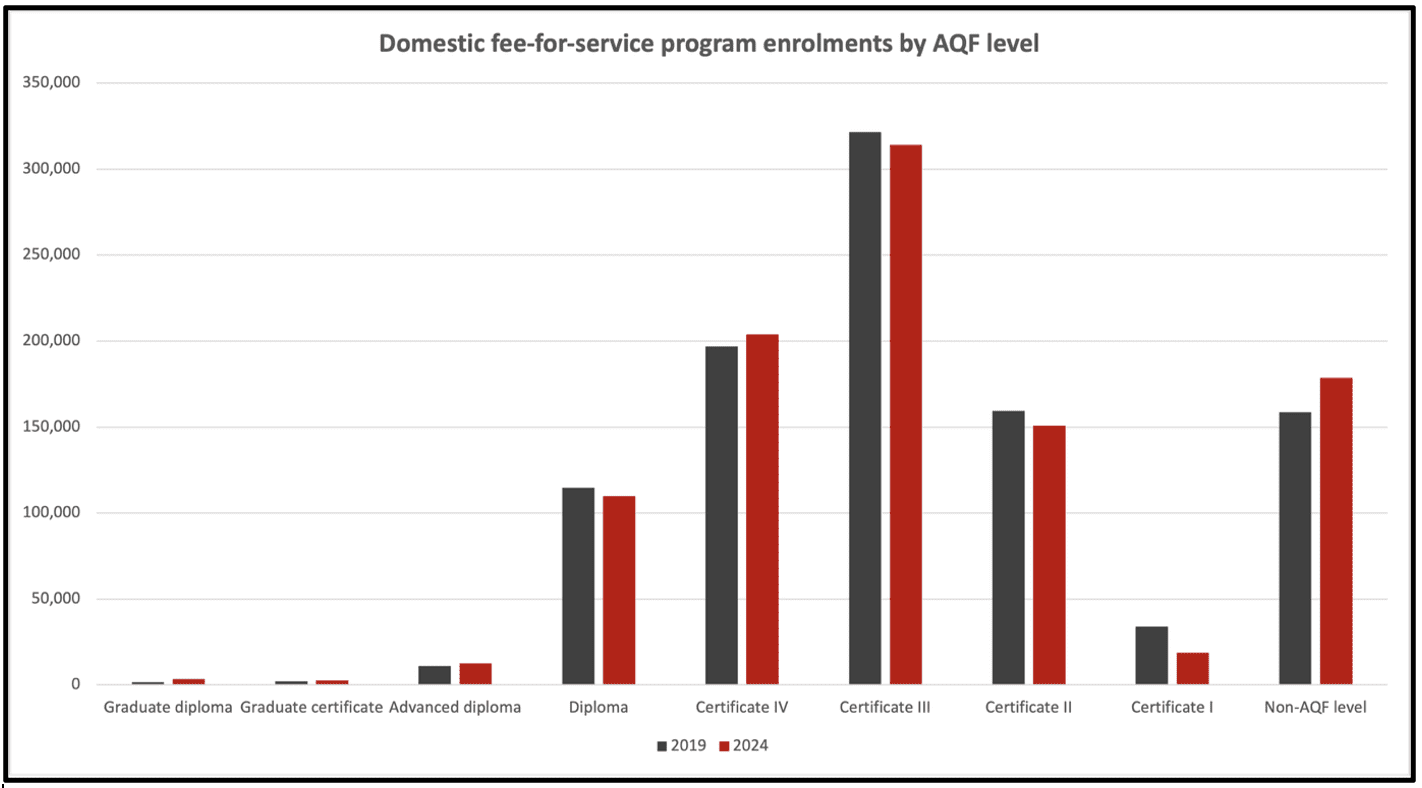
Summary
This analysis of Total VET Activity data shows a modest overall decline in program enrolments (full qualifications and skillsets) of -3% in the decade from 2015, but an 11% increase (an extra 300,000 program enrolments) between 2019 and 2024.
Within TAFE and dual-sector universities, enrolment shifts were mixed: modest growth in community services (+1%) and business (+4%), a small decline in construction (-3%), and sharper movements in electrotechnology (+23%) and tourism, travel and hospitality (-26%).
Overall, TAFE program enrolments dropped slightly (-1%) between 2019-2024, while private providers grew significantly (+18%), although growth slowed between 2023 and 2024.
Government funding trends reveal shifting policy priorities. Since 2019, government-funded program enrolments grew 8%, particularly at Certificate III and IV levels, while Certificate I–II courses declined.
International student program enrolments increased by 40%, even as domestic fee-for-service activity fell slightly.
Notably, most government-funded community services and tourism, travel and hospitality enrolments occur outside the TAFE sector.
Jurisdictional variations in enrolments are evident: while enrolments grew in all states and the NT, the ACT saw a -20% overall fall in students choosing VET between 2019 and 2024. This was driven by a fall in both government-funded (-30%) and fee-for-service (-22%) enrolments.
Collectively these shifts highlight structural differences in demand across industry sectors, funding streams, and provider types.
——————————–
[1] Data from 2015-2019 appears to now only be available as a (paid) special data request.



